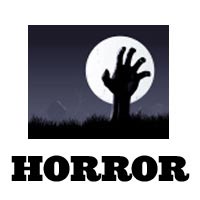Hitchcock's 60s Masterpieces:
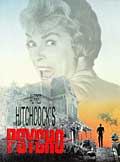 Another
suspense/thriller director, Alfred Hitchcock, whose early silent film The
Lodger (1926) explored horror's themes, brought out his most horrific
film over 30 years later at the start of the decade. His film changed the
face of all horror films ever since. Pure archetypal horror was now to be
found in the dark shadows of the human soul itself - in a psychopathic, cross-dressing
Bates Motel operator and taxidermist (Anthony Perkins). The low-budget, television-influenced,
B & W Psycho (1960) could be considered the 'Citizen Kane' of horror
films, with its complex Oedipal themes and schizophrenia. Its most famous
scene was the classic shower murder in which the heroine (Janet Leigh) was
savagely stabbed, with Bernard Herrmann's violin-tinged memorable score. The
scene still invokes sheer terror, and the film itself would come to influence
all subsequent Hollywood horror films - especially the 'slasher' horror film
subgenre. Another
suspense/thriller director, Alfred Hitchcock, whose early silent film The
Lodger (1926) explored horror's themes, brought out his most horrific
film over 30 years later at the start of the decade. His film changed the
face of all horror films ever since. Pure archetypal horror was now to be
found in the dark shadows of the human soul itself - in a psychopathic, cross-dressing
Bates Motel operator and taxidermist (Anthony Perkins). The low-budget, television-influenced,
B & W Psycho (1960) could be considered the 'Citizen Kane' of horror
films, with its complex Oedipal themes and schizophrenia. Its most famous
scene was the classic shower murder in which the heroine (Janet Leigh) was
savagely stabbed, with Bernard Herrmann's violin-tinged memorable score. The
scene still invokes sheer terror, and the film itself would come to influence
all subsequent Hollywood horror films - especially the 'slasher' horror film
subgenre.
Hitchcock's next horror masterpiece was Universal Studios'
apocalyptic The Birds (1963) about the invasion
of coastal town Bodega Bay by avian flocks. A spoiled heiress (Tippi Hedren),
her potential boyfriend (Rod Taylor), his mother (Jessica Tandy), and a schoolteacher
(Suzanne Pleshette) all suffered from the many bird attacks. The theme of
Man vs. Nature running amok remained unresolved by the film's end.
 Roman
Polanski's Horror Films in the 60s: Roman
Polanski's Horror Films in the 60s:
Polish director Roman Polanski's first film in English, the
potent and scary British production titled Repulsion (1965, UK), depicted
a young, sexually-disturbed beautician's (Catherine Deneuve) unstable descent
into hallucinatory madness in a London apartment. After his public acceptance
for the film, Polanski directed the offbeat ghoulish comedy The Fearless
Vampire Killers (1966) starring his wife Sharon Tate (a victim of the
gruesome Manson 'family' murders).
Polanski's greatest commercial hit was his adaptation of Ira
Levin's best-selling book Rosemary's Baby (1968) that dared to show the struggle of a young pregnant woman (Mia Farrow) against
witches and the forces of the devil (found among friendly senior citizens
on Manhattan's Upper West Side, led by Oscar-winner Ruth Gordon), culminating
in the young woman's delivery and mothering of the devil's child.
Foreign-Made Zombie Films in the 1960s:
(See description of Zombie Films Before the 1960s)
By the mid-1960s, UK's Hammer Studios - known for churning out dozens of horror films, entered into the world of zombies with its The Plague of the Zombies (1966, UK) (aka The Zombie) by director John Gilling, visualizing the living dead as rotting, reanimated (or undead) corpses. Building upon Lugosi's characterization in the 1932 classic film White Zombie, the film told about a wickedly-insane, 19th century Cornish squire with a macabre plot to use ancient voodoo rites to raise plague victims from the dead to become his exploited, voodoo-controlled zombies working in his tin mine. The film's best nightmarish sequence was one in which decaying graveyard cadavers dug their way up through the earth to surround the shocked dreamer and clutch at him with clawing dead fingers. Another notable dream image was a realistic zombie decapitation.
The apocalyptic The Last Man on Earth (1964,
It.), starring Vincent Price as a sole surviving
doctor besieged by bloodthirsty vampire-like plague victims, was
the first film version of Richard Matheson's 1954 novel I Am
Legend (later remade as The Omega Man (1971) starring
Charlton Heston, and in 2007 with the same title starring Will
Smith).
George Romero's Horror Contributions: Modern
Zombie Films
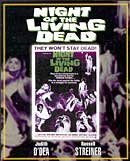 In
a revolutionary way, now-acclaimed George A. Romero, now known as
the Master of the 'zombie film,' ushered in the modern era of graphically violent and gory
zombie pics in the waning years of the 60s decade. Stephen King praised
him for taking the horror "out of Transylvania" and bringing
it to modern-day America. Romero's first Dead film appeared
at the same time as civil unrest, Black Power and student protests,
the Vietnam War, fear of nuclear annihilation, the gruesome assassinations
of Robert Kennedy and Martin Luther King, Jr., and the breakdown
of the family - all coupled with the idealistic innocence of the
previous year's Summer of Love. Romero realized that his archetypal
zombie narratives, with extreme blood, violence and gore, could also
provide worthwhile sub-textual commentary on societal themes. He
recognized that the ultimate in horror was humanity itself ("I
also have always liked the monster-within idea. I like the zombies
being us"), allegorically presented during turbulent times as
mobs of mindless reanimated 'living dead' creatures. In
a revolutionary way, now-acclaimed George A. Romero, now known as
the Master of the 'zombie film,' ushered in the modern era of graphically violent and gory
zombie pics in the waning years of the 60s decade. Stephen King praised
him for taking the horror "out of Transylvania" and bringing
it to modern-day America. Romero's first Dead film appeared
at the same time as civil unrest, Black Power and student protests,
the Vietnam War, fear of nuclear annihilation, the gruesome assassinations
of Robert Kennedy and Martin Luther King, Jr., and the breakdown
of the family - all coupled with the idealistic innocence of the
previous year's Summer of Love. Romero realized that his archetypal
zombie narratives, with extreme blood, violence and gore, could also
provide worthwhile sub-textual commentary on societal themes. He
recognized that the ultimate in horror was humanity itself ("I
also have always liked the monster-within idea. I like the zombies
being us"), allegorically presented during turbulent times as
mobs of mindless reanimated 'living dead' creatures.
Romero's debut horror feature, the first of a canon
of zombie classics, was the low-budget, intensely-claustrophobic,
unrelenting B&W cult classic Night of the Living Dead (1968).
It was a milestone 'splatter' film about newly dead, stumbling corpses/zombies
(not produced by voodoo rites, or outer space mutants), that returned
to life with indiscriminate, ravenous hunger for human flesh. Romero
himself defined them as average-Joe "blue-collar
monsters," who lumbered stiffly out of their graves (due to the
effects of rigor mortis) and toward
a barricaded farmhouse in rural Pennsylvania. Reportedly,
it was thought that the zombies were raised from the dead after exposure
to radiation from a returning Venus space probe. The
amateurish, allegorical film made in just one month showed rotten human
corpses walking with outstretched arms and threatening a few trapped
survivors who sought refuge.
The terror came from their
relentless attack on innocent fugitive survivors who were hiding to
escape being infected by zombie bites. Fire scared off
the walking, bloodthirsty cadavers, and they could only be forever
stopped by a brain kill - shooting them in the head. The low-budget
black-and-white visceral film was shot documentary-style with natural
lighting and a handheld camera to accentuate the fear facing the besieged
farmhouse occupants. Soon, the horror threat was coming from inside
the house as well as outside, as there was a struggle for power between
a resourceful and calm black man (the lead character!) and an impulsive
family man. It also showed violated bodies and families torn apart
by the 'living dead' creatures who illustrated how nothing was sacred
in contemporary society (an adolescent girl killed her own mother with
a garden trowel and then ate her). The film's despairing tone, especially
its tragically ironic ending, struck audiences as a true depiction
of the lifeless dehumanized society in which people lived. In
the film's futile and bleak conclusion, the townsfolk mistakenly shot
and killed black man Ben (Duane Jones) after his desperate fight for
survival.
Romero's most notable horror films -- his calling card
-- were his Dead trilogy
--
in a 'cult of the dead. The entire series of six films by 2010 included:
- Night of the Living
Dead (1968) - "They Won't Stay Dead"
This naturalistic film, shot in stark and grainy black and white,
inaugurated an entire horror subgenre (zombie films with flesh-stalking
cannibals). (See
above) The film was remade in a 3-D
version by producer/director Jeff Broadstreet as Night of the
Living Dead 3D (2006).
- Dawn of the Dead
(1978) - "When there's no more room in HELL, the
dead will walk the EARTH."
It would be another decade's wait for Romero's next gore-filled
sequel which further redefined the zombie film. It was the most
profitable of all of Romero's zombie films, and the one received
most favorably by critics. The tale told of four survivors seeking
refuge in a deserted suburban shopping mall from ravenous, flesh-eating
zombies, and also from a post-apocalyptic nomadic gang of bikers.
The satirical film was a strong indictment of rampant 1970s capitalistic
consumerism and a further perverse critique of the mall culture
and its mentality, as it showed the group looting the shopping
areas of luxuries and living the American dream in a barricaded
storage area with an excess of material goods, distracted while
decaying, undead danger lurked close by. The biting social satire
equated zombies with brainwashed, feet-shuffling, automaton mall
consumers as soothing Muzak played. It was explained why the zombies
congregated there: "Some
kind of instinct. Memory, of what they used to do. This was an
important place in their lives." As
Romero said in an interview, "I've always felt that the real
horror is next door to us, that the scariest monsters are our neighbors." The
film was remade as Dawn
of the Dead (2004) by
Zack Snyder (his feature film debut).
- Day of the Dead (1985) - "The
darkest day of horror the world has ever known."
Now known as the master of the zombie film, Romero
completed his zombie trilogy in the mid-1980s. This third film
was regarded as the most dialogue-rich, and the goriest of the
original trilogy (its climax was non-stop dismemberment, disembowelment,
and beheadings). Although not well-received originally and the
lowest-grossing film in the trilogy, it has since become a cult
classic after revisionist thinking. The claustrophobic horror-fest
told about surviving mad scientists (particularly Dr. Logan (Richard
Liberty), dubbed "Frankenstein")
and officers, who - in an era of Reaganite militaristic politics
obsessed with science - performed sadistic experiments on zombies
in a subterranean bunker and attempted to 'domesticate' and integrate
them back into society, until the zombies revolted. The film cleverly
set the genre on its head again, showing how the living dead were
misunderstood and oppressed. The poorly-received
quasi-remake was director Steve Miner's direct-to-video Day
of the Dead (2008).
- Land of the Dead
(2005) - "The Dead shall Inherit the Earth."
This fourth film of the Dead series posited the apocalyptic
collapse of human society. It was a symbolic 'haves & have-nots'
class-struggle story with prototypical characters. The masses of
poverty-stricken, exploited residents in Pittsburgh, Pennsylvania
were forced to live in the empty, embattled streets. Although protected
by mercenaries, society was overrun by recently-dead zombies or
undead "walkers" nicknamed "stenches" who
were "practicing to be alive." Meanwhile, the elite lived
in a fortified walled-off city known as Fiddler's Green, bordered
on three sides by rivers and lorded over by Paul Kaufman (Dennis
Hopper), a rich and powerful feudal overlord and opportunistic
super-capitalist. Although this film was written before the events
of 9/11/2001, it was released during the era of President George
W. Bush's "War on Terror." To update its significance
for the time, some of the lines of dialogue were revised (e.g., "We
don't negotiate with terrorists"). Although it was an unsubtle
film, it presented the idea that the zombies, led by smartly-evolved
and more advanced "Big Daddy" (Eugene Clark), could be
trained to shoot guns, use tools as weapons, and besiege the corrupt
city. They were portrayed as more human than the humans: "They're
just looking for a place to go."
- Diary of the Dead
(2007) - "Shoot the Dead."
The fifth, low-budget film was considered a modern-day, rebooted
or updated, 21st century reimagining of the first Romero film. It
postulated that political/social unrest - and the zombie infestation
- was now a worldwide phenomenon. Romero designed it for the passive,
detached YouTube and myspace.com media-saturated
generations. The entire movie was a "film-within-a-film" titled The
Death of Death, shot by film students making a B-grade horror
film after they discovered a real zombie uprising. Composed of
first-person video footage (from security surveillance cameras,
news footage, digital camcorders, YouTube, cell-phone cameras,
etc.) with
long takes and hand-held camera shots, it was edited together
by Debra Moynahan (Michelle Morgan), the girlfriend of a posthumously-dead
film-making boyfriend Jason Creed (Josh Close) - and then uploaded
to the Web with 'scary music' added. The students believed
the government was lying about the causes of the zombie resurrection,
and vowed to show the world the truth of what had really happened.
- Survival of
the Dead (2009) - "Survival
Isn't Just For the Living"
The sixth film in Romero's extended trilogy of "dead" zombie
films was, in effect, a tangential sequel or offshoot to the 5th
film with
a returning character, anti-hero Sgt. Crocket (Alan
Van Sprang) who led a rogue group of National
Guardsmen to find refuge on a remote island off the coast of Delaware. It
still presented the thought-provoking idea that the human race might
become zombified if it fought against itself over a long period of
time. The film's major theme was whether flesh-eating zombies, cared
for as loving kin-folk even if 'undead', could be rehabilitated,
and co-exist with humans by learning to eat non-human flesh. The
theme was carried out in the midst of a deadly tribalistic Hatfield-McCoy
feud (O'Flynns vs. Muldoons) fought between two powerful
families, led by rival Irish patriarchs with differing views on coexistence
with neighboring zombies. It was the
least successful film of the series at the box-office, and critically-reviled
by most Romero fans. It was considered a revisionistic version of
the western The Big Country (1958).
Zombie Horror Films to the Present:
See Filmsite's Special Tribute to Zombie Films
After the late 60's, Romero's first zombie film, the revolutionary Night
of the Living Dead (1968) proved to be hugely influential on future zombie films and many were imaginative derivatives or mutated examples, such as:
- Teenage Zombies (1960), a low-budget, teen horror-exploitation
film
- The Astro-Zombies (1968), again with John
Carradine as a mad zombie master who revitalized corpses as super-human
agents
- Children Shouldn't Play With Dead Things (1973)
(aka Revenge of the Living Dead), a low-budget, zombie horror-comedy
- Let Sleeping Corpses Lie (1974, Sp./It.),
a Spanish/Italian production about the recently-revived living dead
- Sugar Hill (1974) (aka The Zombies of Sugar
Hill),
a blaxploitation horror film about a voodoo army of the undead
- Shock Waves (1977), the best of its low-budget
sub-genre - the underwater Nazi zombie movie
- Phantasm (1979), a great low-budget horror
film with an arachnoid, mysterious undertaker villain (not a zombie
really) known as The Tall Man (Angus Scrimm), with series sequels
in 1988, 1994, 1998 and 2016
- Zombi 2 (1979, It.) (aka Zombie), a gory film from director Lucio Fulci; named Zombi 2 to imply that it was a follow-up film to Romero's Dawn of the Dead (1978) (aka Zombi in Italian) a year earlier
- The Alien Dead (1980), directed by legendary
cult director Fred Olen Ray
- Hell of the Living Dead (1980, It./Sp.),
a low-budget, rip-off horror film and camp-cult favorite from Italy
- Zombi Holocaust (1980, It.) (aka Zombie 3), notoriously gory, and one of many copycat Italian zombie movies
- The Beyond (1981, It.), d. Lucio Fulci, a
midnight-movie cult film about the 'gates of hell' underneath a New
Orleans hotel
- Burial Ground: The Nights of Terror (1981,
It.), another of the many grindhouse, depraved, low-budget
gory variants of the Romero zombie films, from Italy
- Dead & Buried (1981), a favorite cult
film about zombies in Potter's Bluff
- The Evil Dead
(1981), d. Sam Raimi; a splendid trilogy of gore-comedy,
including the remake Evil
Dead II (1987) and the sequel Army
of Darkness (1993), with Bruce Campbell as the cult-classic
hero Ash clashing against demonic spirit-possessed zombies
- Night of the Zombies (1981), d. Joel Reed,
a low-budget, cheap horror film thriller about Nazi-zombies
- Creepshow (1982), a multi-story
(five) anthology, directed by zombie Horror Master George A. Romero,
with a script by another horror master, novelist Stephen King.
The first and third stories: "Father's Day" and "Something
to Tide You Over" were zombie-related.
- Night of the Comet (1984), a satirical,
sci-fi disaster comedy of 50's sci-fi/zombie movies
- Lifeforce (1985), d. Tobe Hooper, a sci-fi film
about London over-run by vampirish space zombies
- Re-Animator (1985), based on H.P. Lovecraft's
early 1920s short story (Herbert West: Re-Animator) about
re-animator experimenter Herbert West (Jeffrey Combs), a parody
of Mary Shelley's Frankenstein; followed by two sequels
also by director Brian Yuzna and starring Jeffrey Combs: Bride
of Re-Animator (1989) and Beyond Re-Animator (2003)
- The Return of the Living Dead (1985) parody series, d. Dan O'Bannon,
followed by numerous sequels: Ken Wiederhorn's Return of the Living Dead Part
II (1988), and Brian Yuzna's Return of the Living Dead 3 (1993), and two more films in 2005
- Night of the Creeps (1986), a fast-paced,
campy, schlocky horror-comedy thriller
- I Was a Teenage Zombie (1987), a
low-budget, campy, cheap parody of John Hughes' high-school romance
films - now a satirical zombie romantic comedy
- Zombie High (1987), with Virginia Madsen
 The
Serpent and the Rainbow (1988), d. Wes Craven, based upon the autobiographical
book with the same title from Wade Davis, about a Harvard researcher sent
to Haiti to investigate voodooism and drug-induced zombies; the film reconnected zombies with their voodoo-inspired roots The
Serpent and the Rainbow (1988), d. Wes Craven, based upon the autobiographical
book with the same title from Wade Davis, about a Harvard researcher sent
to Haiti to investigate voodooism and drug-induced zombies; the film reconnected zombies with their voodoo-inspired roots - Pet Sematary (1989), based upon Stephen King's book,
with a sequel in 1992, features demonic revival of the dead
- Redneck Zombies (1989),
a tongue-in-cheek, comic splatterfest zombie movie
- Night of the Living Dead (1990), a re-telling of
the original (with significant changes in the character of Barbra and advanced
production design/make-up), based on an updated script (by executive producer
Romero) and shot in color by makeup wizard and Romero's special effects
expert for NOTLD's two sequels, Tom Savini (with his feature film
directorial debut)
- Black Demons (1991, (It.) (aka Demoni 3),
a low-budget, little-seen Italian production, with some similarities
to the plot of John Carpenter's The Fog (1980)
- Nudist Colony of the Dead (1991), a strange
combination -- a comedy-musical horror spoof. This campy, cheesy,
low-budget B-film had very little nudity
- Voodoo Dawn (1991) (or 1990) (aka Strange
Turf,
and Voodoo Blood), d. Steven Fierberg, adapted from a horror
novel by John Russo (who scripted Night of the Living Dead),
starring Gina Gershon and Tony Todd (pre-Candyman)
- Braindead (1992, NZ) (aka Dead Alive) - director Peter Jackson's early landmark film, often considered the bloodiest and grossest zombie film ever made
- Return of the Living Dead (1993), another
gory comedy yet very straight love story (with some nudity), the
third horror entry in the "Living Dead" series
by director Brian Yuzna
- Cemetery Man (1994, It.) (aka Dellamorte Dellamore),
an intensely erotic, sexy and gory fantasy-horror film - an imaginative,
supernatural romance (and comedy!) about a graveyard
- I, Zombie (1999), the first film produced
by horror magazine Fangoria
- The Dead Hate the Living (2000), debut film
of writer/director Dave Parker, direct to video
- Resident Evil (2002), d. Paul W.S. Anderson, but
originally to be directed by George Romero, adapted from the popular video
game and with numerous Alice in Wonderland references; with sequels
in 2004, 2007, and 2010
- 28 Days Later (2002, UK), a sci-fi
horror film set in London - that has been overrun with a plague and
crazed, diseased zombies due to a bio-hazard virus, the sequel
was 28 Weeks Later (2007, UK)
- House of the Dead (2003),
an inept, reviled zombie film from notorious German-born director
Uwe Boll
- Undead (2003, Australia), a sub-par, low-budget,
independent film that was both a serious film and a parody of sci-fi
(alien invasion) films
- Dawn of the Dead (2004), a remake of Romero's
second film in the original trilogy, from Zack Snyder (his feature
film debut), a bit hit film and the
highest-grossing zombie film at the time
- Shaun of the Dead (2004, UK),
a horror comedy by director Edgar Wright, featuring star and co-writer
Simon Pegg, about two London slackers experiencing a zombie invasion
- They Came Back (2004, Fr.) (aka Les Revenants), a
serious, intellectual, mystery-style movie - and a zombie film
without rotting, shambling, drooling flesh-eating corpses, or blood
and gore
- Black Sheep (2006, NZ), d. Jonathan King, a horror-comedy, about a genetic engineering experiment gone awry by renegade geneticist Dr. Rush (Tandi Wright), that produced 4-legged blood-thirsty mutant killer "zombie" sheep!
- Fido (2006, Canada),
an imaginative, whimsical, and entertaining black horror-comedy
(a boy and his dog tale), with sly satire, and with the sensibility
of a Douglas Sirk 50s melodrama
- The Zombie Diaries (2006, UK), a low-budget
production, a "found footage" film made with a jerky camera,
in the style of The
Blair Witch Project (1999), with a non-linear narrative and
little character development
- Planet Terror (2007) (aka Grindhouse: Planet
Terror), the Grindhouse double-feature
partner with Quentin Tarantino's Death Proof.
- [REC] (2007, Sp.), a found-footage horror
film set in a locked-down apartment building in Barcelona, Spain. Followed
by many sequels [REC] 2 (2009), REC 3: Genesis (2012), and REC
4 (2014).
- Colin (2008, UK), a very low-budget, low-key
indie film (Marc Price's debut feature film) shot on digital video,
and mostly a character study, with very little plot and dialogue,
and told from the personal POV of a zombie.
- Dance of the Dead (2008),
a low-budget, independent horror comedy (John Hughes-style) with
a cast of unknowns. In some ways, it was a hybrid of two zombie
comedy classics: Return
of the Living Dead (1985) and Shaun of the Dead (2004).
- Day of the Dead (2008),
d. Steve Miner, a loose remake (or more appropriately, a "reimagining")
of Romero's 1985 film (the last of his trilogy), Day of the
Dead (1985), but mostly unrelated.
- Deadgirl (2008), a truly original, disturbing,
dark and disgusting exploitative film, and a treatise on female
objectification.
- Pontypool (2008, Can.), a minimalist yet
effective zombie movie, actually a psychological thriller, almost
entirely devoid of zombies
- Zombie Strippers! (2008),
a low-budget naked zombie film made by writer/director Jay Lee,
headlined by XXX-adult film star Jenna Jameson,
a former Penthouse Pet
- Dead Snow (2009, Norway) (aka Død Snø),
a unique Nazi zombie movie - a low-budget, gory horror comedy (and
midnight-movie cult hit)
- Zombieland (2009), a big-budget
successful zombie comedy about a road trip amidst a zombie apocalypse
- The Dead (2010, UK), a sleeper,
low-budget, stark and stripped-down, serious-minded zombie road
film shot on location in the Dark Continent of Africa
- Juan of the Dead (2011, Cuba/Sp.), a rip-off
title of Shaun of the Dead (2004, UK) - and a Latino version
of the earlier film. It was a satirical Spanish-Cuban zombie horror-comedy,
set in Fidel Castro's Cuba, with an astute political subtext.
- Warm Bodies (2013),
a post-apocalyptic, upbeat zombie teen romance-comedy - an original
love story based on Isaac Marion's 2010 novel, similar in part
to Shakespeare's Romeo & Juliet
- World War Z (2013), an apocalyptic action
thriller and zombie creature-film based on Max Brooks' 2006 pseudo-oral
history novel World War Z: An Oral History of the Zombie War.
As of the present time, the massive summer blockbuster was the
highest-grossing zombie film of all time.
Horror Films in the 70s:
In 1968, the MPAA created a new rating system with G, M, R,
and X ratings, in part as a response to the subversive, violent themes of
horror films. The figure of Dracula reappeared in the TV adaptation Dracula (1973) with Jack Palance as the reluctant "undead" vampire and Nigel Davenport as Van Helsing. Director Paul Morrissey's sexy cult horror film Andy Warhol's Dracula (1974) (aka Blood for Dracula), originally rated X but re-rated as R, featured Udo Keir as the blood-addicted, sickly 'junkie' Count seeking virgin blood outside of Transylvania in Italy, although Warhol stalwart Joe Dallesandro (as handsome handyman Mario) had already consumed the virginal attributes of suitable bride-mates. Frank Langella recreated his starring Broadway role as
the charismatic, and suave but tragically-anguished Count in director John Badham's Dracula (1979), with Laurence Olivier as the famed vampire hunter. And in
the same year, the vampire myth was spoofed in director Stan Dragoti's highly-successful and campy Love at First
Bite (1979) with George Hamilton.
In the 1970s, nightmarish horror and terror lurked everywhere.
One of the top box-office hits in the early 70s was Willard (1971) about a wimpish 27 year old loner (and Mama's boy) who trained his bloodthirsty
pet rodent friends to vengefully attack his co-worker enemies - it launched
an equally awful sequel Ben (1972) (with an Oscar nomination for Best
Song for its title song - performed by Michael Jackson). [The cult classic
was remade by writer/director Glen Morgan as Willard (2003), starring
Crispin Glover as the title character.] Master filmmaker Stanley Kubrick's
controversial A Clockwork Orange (1971) was
a brilliant adaptation of Anthony Burgess' novel about rape, murder, and behaviorist
experiments to eradicate aberrant sex and violence. And in the kitschy The
Abominable Dr. Phibes (1971), madman Dr. Anton Phibes (Vincent Price)
let loose Biblical plagues against his victims - physicians who failed to
save the life of his wife (Caroline Munro).
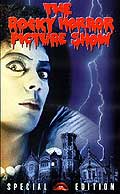 Future
director Steven Spielberg's first notable film (originally made-for-TV) was
the paranoic Duel (1972) about a monstrous and malevolent gas-tank
truck without a driver. Director Nicolas Roeg's psychological thriller Don't
Look Now (1973) duplicated Hitchcockian terror in a tale of disaster in
Venice for Julie Christie and Donald Sutherland. Although it was a musical/comedy,
the cult-campish Frankenstein classic The Rocky Horror Picture Show (1975) was set in a haunted castle with a group of transsexual aliens, and starred
a young Susan Sarandon, Barry Bostwick, and Tim Curry. The weird and bawdy
film soon became a cultural institution and phenomenon as it played for many
years in packed midnight showings, with costumed audience members participating
in the screenings. Jack Starrett's fast-paced horror chase film, Race With
the Devil (1975) starred Peter Fonda and Warren Oates as innocent vacationers
- with their wives (Loretta Swit and Lara Parker) - who are pursued by Satanists
after inadvertently watching them perform a human sacrifice. Future
director Steven Spielberg's first notable film (originally made-for-TV) was
the paranoic Duel (1972) about a monstrous and malevolent gas-tank
truck without a driver. Director Nicolas Roeg's psychological thriller Don't
Look Now (1973) duplicated Hitchcockian terror in a tale of disaster in
Venice for Julie Christie and Donald Sutherland. Although it was a musical/comedy,
the cult-campish Frankenstein classic The Rocky Horror Picture Show (1975) was set in a haunted castle with a group of transsexual aliens, and starred
a young Susan Sarandon, Barry Bostwick, and Tim Curry. The weird and bawdy
film soon became a cultural institution and phenomenon as it played for many
years in packed midnight showings, with costumed audience members participating
in the screenings. Jack Starrett's fast-paced horror chase film, Race With
the Devil (1975) starred Peter Fonda and Warren Oates as innocent vacationers
- with their wives (Loretta Swit and Lara Parker) - who are pursued by Satanists
after inadvertently watching them perform a human sacrifice.
As the decade of the seventies progressed, the horror genre
was subjected to violence, sadism, brutality, slasher films, victims of possession,
and graphic blood-and-gore tales. Director John Boorman's terrifying Deliverance
(1972) examined primeval human evil and included graphic mutilation
and sodomy by crazed hillbillies upon an unsuspecting group of wilderness
adventurers.
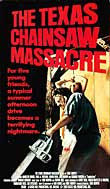 Two
of the most effective, box-office successes of the 70s included
the camp classic It's Alive! (1974) about a murderous baby,
and Tobe Hooper's exploitative, low-budget (reportedly $150,000),
hand-made cult film - The Texas Chainsaw Massacre (1974).
Hooper's notorious first film, about a terrorized group of teenagers,
was loosely based on the true crimes of grisly, notorious Wisconsin
serial killer Ed Gein, as was Hitchcock's Psycho
(1960), Three on a Meathook (1972), Deranged: Confessions
of a Necrophile (1974),
and Jonathan Demme's The Silence of the Lambs
(1991). Two
of the most effective, box-office successes of the 70s included
the camp classic It's Alive! (1974) about a murderous baby,
and Tobe Hooper's exploitative, low-budget (reportedly $150,000),
hand-made cult film - The Texas Chainsaw Massacre (1974).
Hooper's notorious first film, about a terrorized group of teenagers,
was loosely based on the true crimes of grisly, notorious Wisconsin
serial killer Ed Gein, as was Hitchcock's Psycho
(1960), Three on a Meathook (1972), Deranged: Confessions
of a Necrophile (1974),
and Jonathan Demme's The Silence of the Lambs
(1991).
The lead horror character, chain-saw toting, human
skin-mask wearing Leatherface (Gunnar Hansen) was part of a crazed,
inbred family of psychopathic cannibals who ran a human meat-packing
plant. Leatherface was both repulsive and muscular, in his Grand
Guignol pursuit of victims -- five young hippie Texans (including
Marilyn Burns as victimized Sally) to butcher with a power tool.
Its tagline: "Who will survive
and what will be left of them?" hinted at the massacre to follow,
although it was fairly bloodless, surprisingly.
There were
numerous sequels (prequels, remakes, etc.) to the original 1974 Texas
Chainsaw Massacre film,
stretching over 48 years!, with many non-continuous plot lines and
creative connections between the films:
- The Texas Chain Saw Massacre (1974)
- The Texas Chainsaw Massacre 2 (1986), also
directed by Hooper, a very dark comedy starring Dennis Hopper and
Bill Moseley; it was set twelve years after the events of the first
film
- Texas Chainsaw Massacre 3 (1990) (aka
Leatherface: Texas Chainsaw Massacre III), directed
by Jeff Burr, starring Viggo Mortensen and Kate Hodge; it was
a direct sequel to the original that ignored the previous film
- Texas Chainsaw Massacre: The Next Generation
(1994) (aka The Return of the Texas Chainsaw Massacre), directed
by Kim Henkel and featuring future stars Matthew McConaughey
and Renee Zellweger; in the earlier series of films, this was
the last sequel to the original 1974 film
- The Texas Chainsaw Massacre
(2003), a gorefest remake or reboot from producer Michael Bay,
with Jessica Biel as one of the terrorized teenagers; the most successful
of all of the films at $80.5 million (domestic)
- The Texas Chainsaw Massacre: The Beginning
(2006), producer Michael Bay's prequel or origin film
to his rebooted 2003 remake and another direct sequel to the
1974 film, starring Jordana Brewster, Matt Bomer and Doira Baird,
originally rated NC-17 until cuts reduced it to an R-rating
- Texas Chainsaw 3D (2013)
- Leatherface (2017)
- Texas Chainsaw Massacre (2022)
In early 2013, the Leatherface franchise received
a face-lift (or another reboot) with the production of the seventh
installment of the original, Texas
Chainsaw 3D (2013), a direct sequel (that ignored all the other
films), directed by John Luessenhop. The homicidal maniac Leatherface
was portrayed by Dan Yeager, with Alexandra Daddario as his victim
Heather. The film featured cameos of previous TCM actors, including
Marilyn Burns (Sally in the original), John Dugan (Leatherface's
grandfather), and even Leatherface (Gunnar Hansen) himself. And
an eighth film followed - another prequel to the 1974 film and the
2013 film, titled Leatherface
(2017), followed by a 9th film: Texas Chainsaw Massacre (2022).
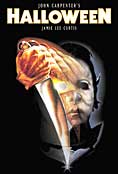 John
Carpenter's influential, and acclaimed independent-sleeper horror
classic Halloween (1978) with a creepy
soundtrack brought about the modern slasher movie. It featured the
iconic character of Michael Myers - a deranged, threatening knife-wielding
killer of teenage babysitters (notably Jamie Lee Curtis in her debut
film as Laurie Strode, the daughter of Janet Leigh who had earlier
starred as the 'scream queen' in Hitchcock's Psycho) who
had returned to his old neighborhood of Haddonfield, Illinois after
an escape from a mental institution. His spooky doctor Sam Loomis
(British horror actor Donald Pleasence) pursued the mad slasher as
the masked killer wreaked havoc and menace. [Note: The mask was actually
a costume store William Shatner-like faceplate, turned inside out
and painted white.] The film brought about the Puritanical cliched
notion that promiscuous, sex-loving teenagers were marked for death. John
Carpenter's influential, and acclaimed independent-sleeper horror
classic Halloween (1978) with a creepy
soundtrack brought about the modern slasher movie. It featured the
iconic character of Michael Myers - a deranged, threatening knife-wielding
killer of teenage babysitters (notably Jamie Lee Curtis in her debut
film as Laurie Strode, the daughter of Janet Leigh who had earlier
starred as the 'scream queen' in Hitchcock's Psycho) who
had returned to his old neighborhood of Haddonfield, Illinois after
an escape from a mental institution. His spooky doctor Sam Loomis
(British horror actor Donald Pleasence) pursued the mad slasher as
the masked killer wreaked havoc and menace. [Note: The mask was actually
a costume store William Shatner-like faceplate, turned inside out
and painted white.] The film brought about the Puritanical cliched
notion that promiscuous, sex-loving teenagers were marked for death.
[This popular slasher, serial killer film inspired
numerous, mostly inferior sequels -
a total of ten films by the year 2009, and then an 11th film (a direct
sequel) in 2018, and additional films in 2021 and 2022. The only
film in the series without Michael Myers was the third installment
in 1982.]
Halloween's series of 13 films (from 1978-2022)
grossed $624 million domestically. The highest-grossing of the
series was the latest remake-installment Halloween (2018),
a true sequel to the original film, earning $159.3 million (domestic).
It also became the highest-grossing slasher film of all-time. It
brought back actress Jamie Lee Curtis 40 years later as an aging,
twice-divorced Laurie Strode who was suffering from alcoholism and
agoraphobia.
Steven Spielberg's
second horror film Jaws (1975) - was a terrific summer blockbuster about a threatening
great white shark off an Eastern beach community - Amity Island. Horrible
conflicts could occur with supernatural, Jaws-like monsters in space,
such as in director Ridley Scott's Alien (1979),
with the tagline: "In space, no one can hear you scream." The monster's
defeat called for a superhuman power or effort to destroy the threatening
evil. A heroine (Sigourney Weaver) challenged the murderous alien invader
within the dark and creeky Nostromo. There were three more Alien films in a continuing franchise. An adapted Stephen King tale provided
the basis for Stanley Kubrick's masterfully-directed gothic film The
Shining (1980) about a crazed husband and alcoholic, failed wannabe writer (Jack Nicholson) with personal
demons in the Overlook Hotel, closed and snowbound for the winter in Colorado. With an axe, he murderously terrorized
his emotionally-abused, hysterical wife Wendy (Shelley Duvall) and psychic young son Danny (Danny Lloyd), who possessed the special mental power of 'shining' (visions of previous homicides).
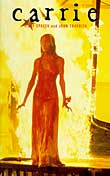 Italian
cult horror film director Dario Argento (sometimes called "The Italian Hitchcock") featured gory, blood-and-guts special
effects in the malevolent, art-horror, stylistic classic Suspiria (1977, It.). The horror fantasy starred Jessica Harper as an aspiring American ballerina dancer in a European ballet academy in the Black Forest of Germany
run by witches led by the "Black Queen" headmistress Madame Blanc (Joan Bennett). The film opened with a stunning set-piece of the bloody deaths of two female students. Argento also directed its surrealistic sequel, Inferno (1980) involving a search for the "Mother of Darkness" in Manhattan, and the bloody thriller Unsane (1982) (originally titled Tenebrae). Italian
cult horror film director Dario Argento (sometimes called "The Italian Hitchcock") featured gory, blood-and-guts special
effects in the malevolent, art-horror, stylistic classic Suspiria (1977, It.). The horror fantasy starred Jessica Harper as an aspiring American ballerina dancer in a European ballet academy in the Black Forest of Germany
run by witches led by the "Black Queen" headmistress Madame Blanc (Joan Bennett). The film opened with a stunning set-piece of the bloody deaths of two female students. Argento also directed its surrealistic sequel, Inferno (1980) involving a search for the "Mother of Darkness" in Manhattan, and the bloody thriller Unsane (1982) (originally titled Tenebrae).
Master of Horror Brian De Palma:
In the early 1970s, shock director Brian DePalma (often using
film techniques comparable to horror Master Alfred Hitchcock) emerged as a
significant contributor to the horror genre, breaking out with his original
mainstream film Sisters (1973), followed by his first commercial hit Carrie (1976) - an adaptation of writer Stephen King's best-selling 1974
debut novel about a socially-outcast, shy, abused and bullied schoolgirl (Sissy Spacek) possessed with
retributive telekinetic powers, and her religious fanatic mother (Piper Laurie).
After the psychic phenomenon thriller The Fury (1978), De Palma's next successful film was the erotic horror/thriller Dressed to Kill
(1980) about a transvestite therapist/stalker (Michael Caine), with a marvelous seduction-stalking
scene of Kate Miller (Angie Dickinson) in a museum, a razor-slashing murder in an elevator, and ending with an imitative Psycho-shower scene.
Devil-Possession and Devil-Child Films:
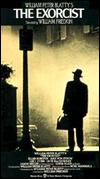 Evil
spirits possessed the body of a young 12 year-old girl (Linda Blair) in director
William Friedkin's manipulative critical and box-office success The
Exorcist (1973) from William Peter Blatty's best-selling novel, with
extravagant, ground-breaking special effects and startling makeup. Its twisting
head, pea-soup vomit spewing, crotch-stabbing with a crucifix, and other horrific visuals terrified audiences.
The blockbuster, about the attempted exorcism of the demonic entity by two
priests (Max von Sydow and Jason Miller), inspired inferior sequels of its
own: Evil
spirits possessed the body of a young 12 year-old girl (Linda Blair) in director
William Friedkin's manipulative critical and box-office success The
Exorcist (1973) from William Peter Blatty's best-selling novel, with
extravagant, ground-breaking special effects and startling makeup. Its twisting
head, pea-soup vomit spewing, crotch-stabbing with a crucifix, and other horrific visuals terrified audiences.
The blockbuster, about the attempted exorcism of the demonic entity by two
priests (Max von Sydow and Jason Miller), inspired inferior sequels of its
own:
- The Exorcist (1973)
- Exorcist II: The Heretic
(1977), d. John
Boorman (with Linda Blair reprising her role as a 16 year-old,
4 years after the events of the original film)
LONG GAP BETWEEN FILMS
- The Exorcist III (1990), d. William Peter
Blatty (based on his book 1983 book Legion); set 15 years
after the events of the 1973 film, and skipping over the 2nd film
- Exorcist: The Beginning (2004), d. Renny
Harlin; a prequel [Note: It was reworked from Schrader's already-completed
2005 film - see next]
- Dominion: Prequel to the Exorcist (2005), d. Paul
Schrader; another prequel
- The Exorcist: Believer (2023), d. David
Gordon Green, a direct sequel to the original 1973 film
Some of the better devil-possession sequels in the late 70s
and early 80s were The Amityville Horror (1979) about a devilish haunted
house, Tobe Hooper's Poltergeist (1982) - a
supreme ghost story about menacing spirits that kidnap a young child (in a
film produced, co-written and 'co-directed' by Steven Spielberg) by sucking
her into a TV set ("They're heeere!") and taking her into a parallel
dimension. Poltergeist encouraged two sequels in 1986 and 1988. The Omen (1976), with a memorable score by Jerry Goldsmith, about a young
adopted son (of parents Gregory Peck and Lee Remick) named Damien - Satan's
son, also inspired two sequels to compose a trilogy: Damien: Omen II (1978),
and The Final Conflict (1981)). There was also a made-for-cable TV
sequel titled Omen IV: The Awakening in 1991.
Other devil films included:
Taylor Hackford's The Devil's Advocate (1997) with tempting
Al Pacino, and Peter Hyams' action horror thriller End of Days (1999) with
Gabriel Byrne as the seductive Devil Lord. |
